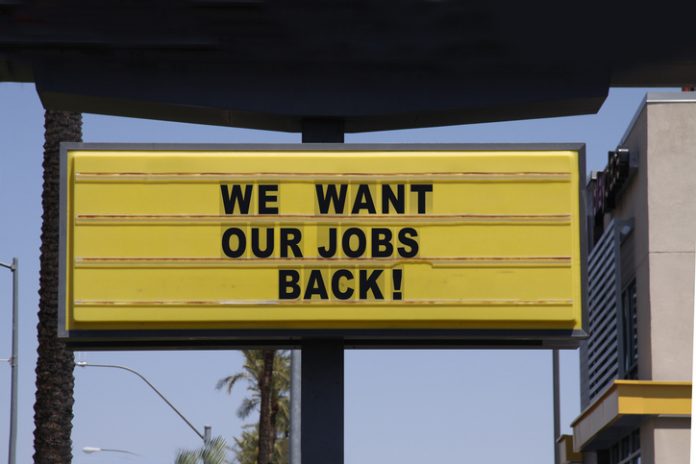COVID-19 restrictions imposed by states held more costs than benefits, according to a statistical analysis of measures adopted by states to quell the spread of COVID-19.
States with Democratic governors saw their unemployment rates increase by 1.5 percent more on average than the increase in unemployment in states with Republican governors during 2020, according to Rogers’ report. A statistical procedure known as a “comparison of means test” revealed that the difference in the average change of unemployment in the two sets of states was statistically significant.
“Democratic states would have seen around 924,000 more of their residents employed if they had experienced the lower increase in unemployment that the aggregated Republican states experienced,” states the report by James R. Rogers, an associate professor of political science at Texas A&M University, and published as an essay by Law & Liberty.
“More-aggressive closure and stay-at-home policies merely imposed additional costs on the people in those states without conferring any additional benefits on them in compensation for those costs,” Rogers writes.
Most anti-COVID policies were imposed at the state level, and Johnson’s research revealed that people living under Democratic and Republican governors fared quite differently during the pandemic.
“Americans in states with Democratic governors may have paid a steep economic cost for those governors’ more aggressive anti-COVID policies relative to the more cautious responses of (most) Republican governors,” Rogers writes. “And despite their costliness, preliminary evidence suggests that more aggressive policies in Democratic states did not result in any greater reduction in COVID mortalities in those states.”
The Difference a Year Makes
“Looking at absolute numbers rather than relative changes, in December 2019, the aggregated unemployment rate in states with Democratic governors was only slightly higher than aggregated unemployment rates in states with Republican governors – 3.76 percent in Democratic states versus 3.34 percent in Republican states,” Rogers points out. “One pandemic year later, unemployment rates in Democratic states had increased to 7.35 percent while it increased in Republican states to only 5.87 percent.
“While only a rudimentary statistical comparison,” Rogers writes, “given the evidence, it is a least a plausible hypothesis that the different increases in unemployment between Democratic and Republican states in 2020 reflect the impact of different pandemic policies adopted by the different governors in the different states.”
‘Zero’ Benefits from Lockdowns
The lockdown policies provided no benefits that could offset the costs, Rogers found.
“If the more aggressive pandemic policies adopted by Democratic governors resulted in significantly lower death rates due to COVID, then the benefits of those policies in the form of lower mortality rates could outweigh the higher unemployment and other economic costs of those policies,” Rogers writes. “The benefits of those more aggressive policies would have been worth the cost.”
“Yet preliminary evidence suggests that, on average, the net benefits of Democratic policies over Republican policies in reducing COVID deaths is zero,” Rogers says. “There is no difference in COVID fatality rates between Republican and Democratic states, this despite the generally more vigorous policy responses to the pandemic of Democratic governors and the generally more restrained responses of Republican governors.”
The Key: Jobless Numbers
A statistical procedure known as a “comparison of means test” reveals the difference in the average change of unemployment in the two sets of states was statistically significant.
Rogers says he employed a simple comparison of means (aka averages) of the change in unemployment during the pandemic year in states with Democratic governors and states with Republican governors.
“Because Republican states average smaller populations than Democratic states, translating these differences in state unemployment rates into a numerical estimate of excess unemployment in Democratic states relative to Republican states isn’t straightforward,” Rogers notes (emphasis in the original).
To get around this problem, Rogers lumped all-Republican state populations together as if people in Republican states lived in one aggregated Republican unit and lumped Democratic state populations together in a separate Democratic unit. Under this scenario, unemployment increased in this aggregated Democratic unit by 1.06 percent more than in the aggregate of Republican states.
For the change in unemployment rates, Rogers used seasonally adjusted data reported by the U.S. Bureau of Labor for December 2019 and December 2020. Rogers then subtracted the respective state unemployment rates to get the change in unemployment rates over the year. Rogers separated the data by the party affiliation of the states’ governors during 2020. The average change in unemployment rates was computed separately for states with Democratic governors and for states with Republican governors.
Bonner R. Cohen, Ph.D., (bcohen@nationalcenter.org) is a senior fellow at the National Center for Public Policy Research.
Internet info:
James R. Rogers, “Shutdowns Offered Only Costs, No Benefits,” Law & Liberty, March 23, 2021: https://lawliberty.org/shutdowns-offered-only-costs-no-benefits/





















